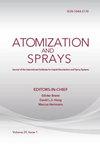Direct Puffing Simulation of Miscible and Emulsified Multicomponent Single Droplets
IF 0.9
4区 工程技术
Q4 ENGINEERING, CHEMICAL
引用次数: 0
Abstract
The aim of the present study is to achieve direct simulation of the puffing of a multicomponent droplet using interface capturing approaches. A non-ideal multicomponent phase equilibrium model is used to determine the composition of boiled vapour. Firstly, the puffing of a two-miscible-component (ethanol:water=1:1 in wt.%) droplet in two-dimensional configuration is directly simulated. The distribution of ejected vapour is impacted by a rotating and shape oscillating satellite droplet. The ejected vapour contains much more ethanol than water, facilitating the transport of the volatile fuel component inside the droplet to the ambient air. The morphological changes to the droplet induced by puffing promote considerably the contact of the boiling surface with air, significantly increasing the scalar dissipation rate of vapour/air. The effects of the nucleation bubble location and droplet temperature on puffing were investigated. Secondly, the puffing of an emulsified three-component (ethanol/water in dodecane) droplet in two-dimensional configuration is simulated. Grid independency has been checked for both the two-miscible-component and three-component emulsified droplet cases. Depending on the water volume fraction in the sub-droplet, which varies from 10% to 70% and is the key parameter herein, both one and two breakups of the parent dodecane droplet are observed. The characteristics of the sub-droplet “invasion” towards the inside of the parent dodecane droplet are investigated, together with the puffing statistics on the puffing delay time, satellite droplet size, surface areas of both the sub- and parent droplets, and oscillation dynamics of the sub-droplet.混溶和乳化多组分单液滴的直接膨化模拟
本研究的目的是利用界面捕捉方法直接模拟多组分液滴的膨化。采用非理想多组分相平衡模型来确定沸腾蒸汽的成分。首先,直接模拟了二维构型的双混合物(乙醇:水的重量比为 1:1)液滴的膨化。喷出蒸汽的分布受到旋转和形状摆动卫星液滴的影响。喷射出的蒸汽中乙醇的含量远高于水,从而促进了液滴内部挥发性燃料成分向环境空气的传输。膨化引起的液滴形态变化大大促进了沸腾表面与空气的接触,显著提高了蒸汽/空气的标量耗散率。研究了成核气泡位置和液滴温度对膨化的影响。其次,模拟了二维结构中乳化三组分(十二烷中的乙醇/水)液滴的膨化。对双混合物和三混合物乳化液滴的网格独立性进行了检验。根据子液滴中水的体积分数(从 10% 到 70% 不等)(这是本文的关键参数),可以观察到母体十二烷液滴的一次和两次破裂。研究了子液滴 "入侵 "母十二烷液滴内部的特征,以及膨化延迟时间、卫星液滴大小、子液滴和母液滴的表面积和子液滴振荡动力学的膨化统计。
本文章由计算机程序翻译,如有差异,请以英文原文为准。
求助全文
约1分钟内获得全文
求助全文
来源期刊

Atomization and Sprays
工程技术-材料科学:综合
CiteScore
2.10
自引率
16.70%
发文量
54
审稿时长
1.7 months
期刊介绍:
The application and utilization of sprays is not new, and in modern society, it is extensive enough that almost every industry and household uses some form of sprays. What is new is an increasing scientific interest in atomization - the need to understand the physical structure of liquids under conditions of higher shear rates and interaction with gaseous flow. This need is being met with the publication of Atomization and Sprays, an authoritative, international journal presenting high quality research, applications, and review papers.
 求助内容:
求助内容: 应助结果提醒方式:
应助结果提醒方式:


